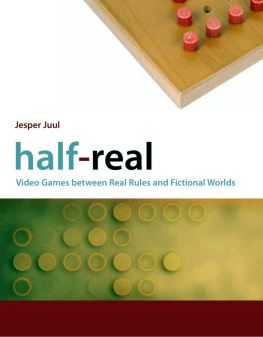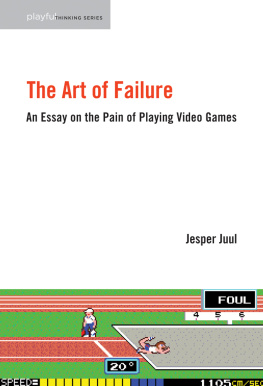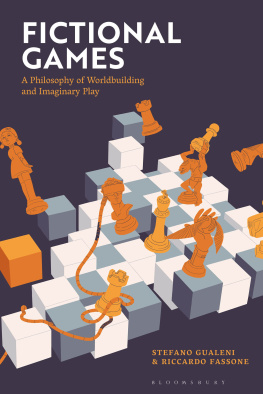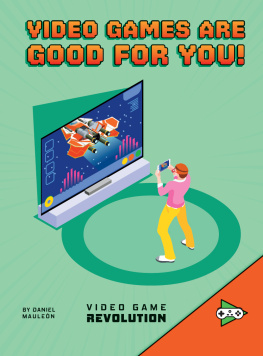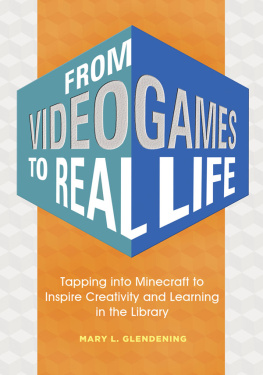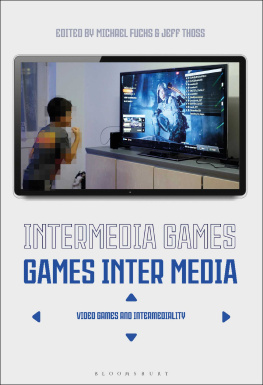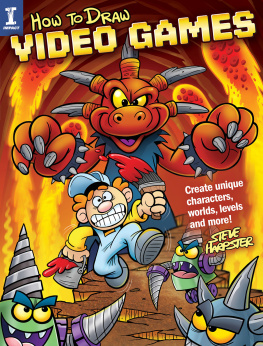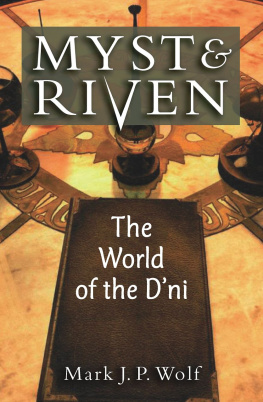Juul - Half-Real: Video Games between Real Rules and Fictional Worlds
Here you can read online Juul - Half-Real: Video Games between Real Rules and Fictional Worlds full text of the book (entire story) in english for free. Download pdf and epub, get meaning, cover and reviews about this ebook. year: 2011, genre: Computer / Science. Description of the work, (preface) as well as reviews are available. Best literature library LitArk.com created for fans of good reading and offers a wide selection of genres:
Romance novel
Science fiction
Adventure
Detective
Science
History
Home and family
Prose
Art
Politics
Computer
Non-fiction
Religion
Business
Children
Humor
Choose a favorite category and find really read worthwhile books. Enjoy immersion in the world of imagination, feel the emotions of the characters or learn something new for yourself, make an fascinating discovery.
Half-Real: Video Games between Real Rules and Fictional Worlds: summary, description and annotation
We offer to read an annotation, description, summary or preface (depends on what the author of the book "Half-Real: Video Games between Real Rules and Fictional Worlds" wrote himself). If you haven't found the necessary information about the book — write in the comments, we will try to find it.
Juul: author's other books
Who wrote Half-Real: Video Games between Real Rules and Fictional Worlds? Find out the surname, the name of the author of the book and a list of all author's works by series.
Half-Real: Video Games between Real Rules and Fictional Worlds — read online for free the complete book (whole text) full work
Below is the text of the book, divided by pages. System saving the place of the last page read, allows you to conveniently read the book "Half-Real: Video Games between Real Rules and Fictional Worlds" online for free, without having to search again every time where you left off. Put a bookmark, and you can go to the page where you finished reading at any time.
Font size:
Interval:
Bookmark:

Jesper Juul
vii
1 1
It began on a slow summer afternoon, playing countless games of tic-tactoe against a childhood friend. The contest was exhilarating, and we tracked the tally carefully until, to our surprise, every game began ending up as a draw. This was unexpected, but we had reached a point where we understood the game well enough to play it perfectly. We had exhausted the game, and we discussed its strategic patterns: If your opponent begins in the middle, always pick a corner.
Some time later, at the age of eleven, I created a racing game on an early computer terminal: I drew a racetrack made of Xs and moved the cursor around the track as quickly as I could (timing each lap with a digital watch), carefully making sure that my car (the cursor) did not collide with the barriers (the Xs). My game looked something like this:

I Figure P.1 I
Almost a video game.
What had I created? It was a game by most counts. But it was and it was not a video game: It took place on a screen, and though the terminal's processing power was modest, I had really designed a game on a computer. However, it was not a video game in the usual sense since it was me, and not the computer, that was upholding the rules.
In addition to setting up the rules of the game, I had also performed an act of imagination-I imagined the green characters on the black screen to be something else, a racetrack and a car, and I imagined that the movement of the cursor was the movement of a car. None of this required any cleverness: setting up a game with rules and goals was easy because I had at that time been exposed to hundreds or perhaps thousands of games, and imagining a rectangular cursor I to be something else-a car-is easy for a child. I had also tried and thoroughly enjoyed a handful of computer and video games, and I sensed that there was a basic connection between computers and games. It was a connection that I urgently wanted to explore.
While the present book is the result of many twists and turns and changes of mind, it is also a book whose basic issues are clearly visible in the tictac-toe bout and in my crude video game of some twenty-three years ago: What does it take for something to be a video game, and when is a video game enjoyable? How do rules in games work, and how do they provide enjoyment for players? How and why does the player imagine the world of a game?
As for the first question, the object of this book is games played using computer power, where the computer upholds the rules of the game and where the game is played using a video display. I will be using video games as an umbrella term to describe all such PC, console, arcade, and other digital games.
I must thank the following bright minds for influencing me during the creation of this book: Susana Pajares Tosca, Lisbeth Klastrup, Espen Aarseth, Aki Jarvinen, Gonzalo Frasca, Marie-Laure Ryan, Markku Eskelinen, Troels Degn Johansson, Henry Jenkins, Eric Zimmerman, Jill Walker, Mikkel Holm Sorensen, Simon Egenfeldt-Nielsen, Peter Bogh Andersen, Lars Konzack, T. L. Taylor, Miguel Sicart Vila, Kim Forum Jacobsen, Noah Wardrip-Fruin, Clara Fernandez-Vera, Chaim Gingold, Anker Helms Jorgensen, Rasmus Keldorff, and the people at MIT Press.
Thanks to Mads Rydahl for the line art and thanks to the tireless readers, Susana and Lisbeth.
The precursor of the book was produced on a Ph.D. grant at the IT University of Copenhagen between October 2000 and October 2003. Much of it was written between February and July 2003 during my stay at Comparative Media Studies, MIT, in Cambridge, Massachusetts.
Some parts of this book have previously been published:
Most of chapter 2 was published as "The Game, the Player, the World: Looking for a Heart of Gameness," in Level Up: Digital Games Research Conference Proceedings, edited by Marinka Copier and Joost Raessens, 30-45. Utrecht: Utrecht University, 2003.
Part of chapter 3's section on emergence and progression was published as "The Open and the Closed: Games of Emergence and Games of Progression," in Computer Games and Digital Cultures Conference Proceedings, edited by Frans Mayra, 323-329. Tampere: Tampere University Press, 2002.
An earlier version of chapter 4's section on time was published as "Introduction to Game Time," in First Person: New Media as Story, Performance, and Game, edited by Noah Wardrip-Fruin and Pat Harrigan, 131-142. Cambridge, Mass.: MIT Press, 2004.
Parts of the conclusions were published as "Just What Is It That Makes Computer Games So Different, So Appealing?," Ivory Tower column for IGDA, April 2003. Available at .
Some of the notes on Grand Theft Auto III were taken from the article "Hvad Spillet Betyder" [What the Game Means], in Digitale Verdener, edited by Ida Engholm and Lisbeth Klastrup, 181-195. Copenhagen: Gyldendal, 2004.
In the title, Half-Real refers to the fact that video games are two different things at the same time: video games are real in that they consist of real rules with which players actually interact, and in that winning or losing a game is a real event. However, when winning a game by slaying a dragon, the dragon is not a real dragon but a fictional one. To play a video game is therefore to interact with real rules while imagining a fictional world, and a video game is a set of rules as well as a fictional world.
Legend of Zelda: The Wind Waker (Nintendo 2003a) in figure 1.1 has been praised for its expressive graphics, lavish world, and detailed storyline. In the picture, the player's character has traveled far from his home island in search of his recently abducted little sister. In addition to the fictional world of the game, not only does a variety of on-screen displays provide the player with much information, there is also a curious arrow bouncing over the small girl in the flower field. The arrow indicates that we are playing a game with rules and a goal to work toward. It tells us that we can interact with the girl, and that she may help us progress in the game. It also illustrates that although the graphics depict an elaborate fictional world, only a small part of this world is actually implemented in the rules of the game; and the arrow indicates which part of the game fiction can also be found in these rules. Thereby Legend of Zelda: The Wind Waker points to a fictional world, and it points to the rules of the game. These are the two things that video games are made of: real rules and fictional worlds.
In having fictional worlds, video games deviate from traditional nonelectronic games that are mostly abstract,' and this is part of the newness of video games. The interaction between game rules and game fiction is one of the most important features of video games, and it is a central theme of this book. Their interaction is present in many aspects of games: in the design of the games themselves; in the way we perceive and use games; and in the way we discuss games. This interaction gives the player a choice between imagining the world of the game and seeing the representation as a mere placeholder for information about the rules of the game.
Font size:
Interval:
Bookmark:
Similar books «Half-Real: Video Games between Real Rules and Fictional Worlds»
Look at similar books to Half-Real: Video Games between Real Rules and Fictional Worlds. We have selected literature similar in name and meaning in the hope of providing readers with more options to find new, interesting, not yet read works.
Discussion, reviews of the book Half-Real: Video Games between Real Rules and Fictional Worlds and just readers' own opinions. Leave your comments, write what you think about the work, its meaning or the main characters. Specify what exactly you liked and what you didn't like, and why you think so.

